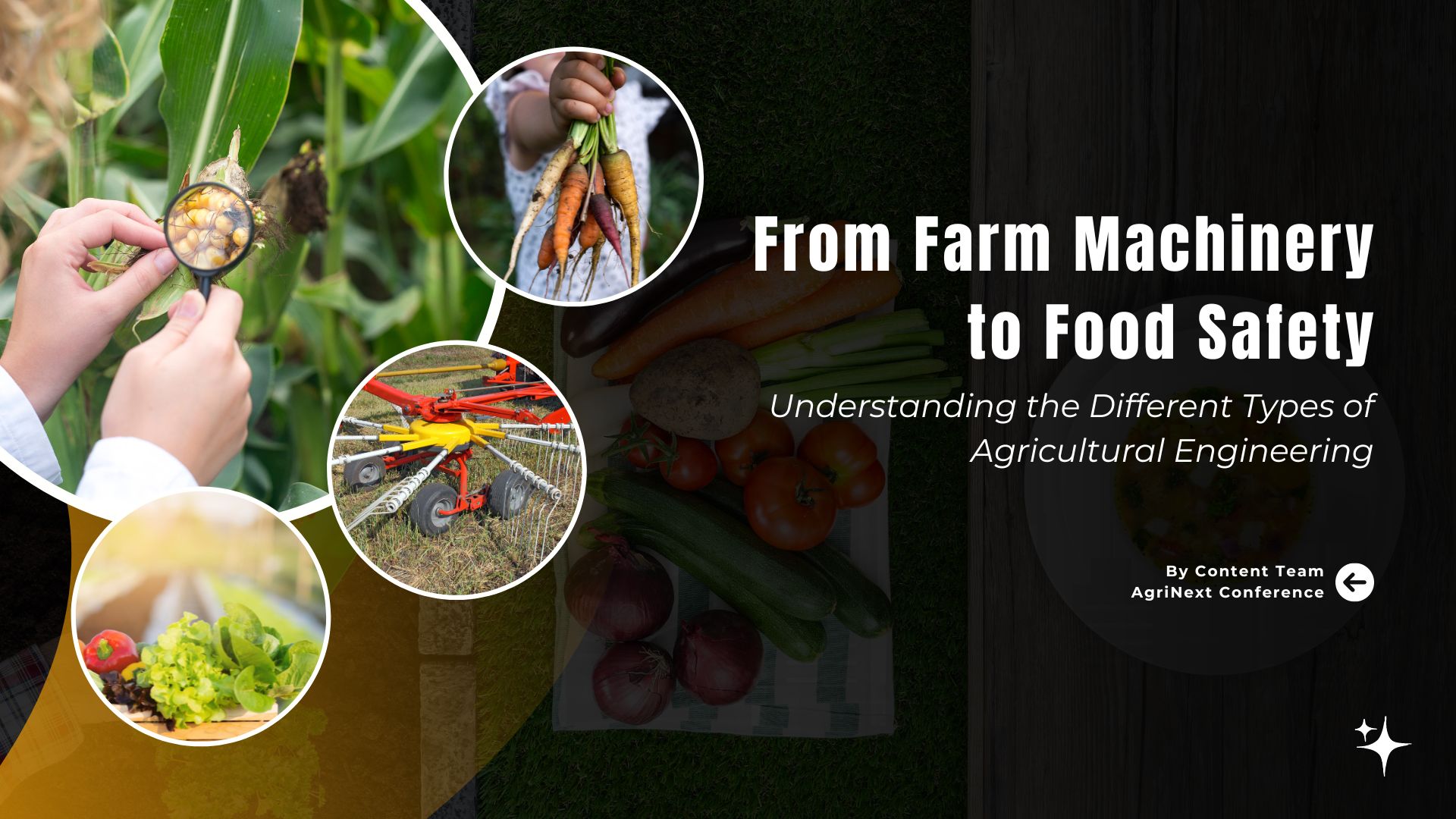
Agricultural engineering, also known as agricultural and biosystems engineering, is the field of study and application of engineering science and designs principles for agriculture purposes, combining the various disciplines of mechanical, civil, electrical, food science, environmental, software, and chemical engineering to improve the efficiency of farms and agribusiness enterprises as well as to ensure sustainability of natural and renewable resources.
In this blog, we will explore the world of Agricultural Engineering, a crucial discipline that combines engineering principles with agricultural practices to solve industry challenges. We will delve into what this field entails, appreciate its rich history, and examine the various roles and responsibilities of agricultural engineers. Additionally, we will investigate the diverse types of agricultural engineering and their impact on modern farming.
Agricultural Engineering: A Brief History
The field of Agricultural Engineering has a rich and varied history. In the early 20th century, agricultural engineering was largely focused on engine-powered machinery for farms, like tractors and harvesters. Over time, it evolved to address a variety of other issues, such as irrigation and drainage, farm structures, and soil and water conservation.
One early achievement in agricultural engineering was the development of the grain elevator in the late 1840s, which paved the way for more efficient grain storage and transport. This innovation significantly improved the handling and movement of large quantities of grain, making the process faster and less labour-intensive.
As the 20th century progressed, agricultural engineers continued to develop technologies and practices that enhanced agricultural productivity and sustainability. From precision irrigation systems to advanced soil management techniques, the field has continually adapted to meet the changing needs of agriculture.
Understanding the Types of Agricultural Engineering
Agricultural engineering plays a pivotal role in the modernization and sustainability of farming practices. It combines engineering principles with agricultural knowledge to solve problems and enhance productivity.
Here’s an overview of the main types of agricultural engineering:
Farm Power and Machinery Engineering
The field of Farm Power and Machinery focuses on the design, development, and maintenance of machinery used in farming. It includes:
Tractors: Essential for various farm tasks like ploughing, planting, and harvesting.For example, John Deere is a leading manufacturer of innovative farm machinery.
Harvesters: Machines that efficiently gather crops from the fields,such as the New Holland CR Revelation series.
Irrigation Systems: Devices and infrastructure that provide water to crops, improving yield and conserving water,like those developed by Netafim, a global leader in precision irrigation solutions.
Advancements in this field aim to increase productivity, reduce manual labour, and enhance the efficiency of farming operations.
Soil and Water Conservation Engineering
Soil and water are the two basic natural resources that sustain life on the Earth. The soil, plant and water interactions are pivotal to enhance productivity to meet the challenge of food security.
Soil and water engineering deals with the sustainable management and conservation of soil and water resources. Key areas include:
Irrigation Systems: Technologies designed to optimize water usage for crops.The International Water Management Institute (IWMI) focuses on sustainable water use in agriculture.
Drainage Systems: Solutions to remove excess water from soil, preventing crop damage.
Soil Erosion Control: Methods to prevent soil degradation and maintain soil health.
This type of engineering ensures that natural resources are used efficiently and sustainably, supporting long-term agricultural productivity.
Food and Bioprocess Engineering
The Role of Food and Bioprocess Engineers in the Growing Food Industry
The food industry, a significant part of the nation’s economy, is growing steadily due to changing consumer needs and increased awareness of nutritional and environmental issues. Food and bioprocess engineers play a crucial role in this sector by developing processes to convert raw farm materials into food products.
Key Areas of Focus:
Application of Engineering Principles
- Processing and production of food.
- Ensuring food safety and health benefits.
Innovative Food Packaging
- Developing new methods to improve food packaging.
Improving Food Quality
- Working on techniques to enhance the quality of food products.
Food Storage Practices
- Developing better food storage methods to prolong shelf life and maintain quality.
Enhancing Food Production Techniques
- Creating more efficient and sustainable food production processes.
Handling Processing Wastes
- Managing waste generated from food processing.
- Finding alternative uses for biological materials (e.g., using newspaper and soy flour for construction materials or corn stalks for chemical absorbent pads).
Food and bioprocess engineers are vital in transforming raw agricultural products into food and other bioproducts, contributing to the industry’s innovation and sustainability.
Agricultural Structures and Environmental Engineering
Agricultural Structures and Environmental Control, revolves around the development of structures and systems designed to facilitate agricultural practices whilst managing the environmental impact.This field involves the design and construction of agricultural structures such as barns, silos, and greenhouses. It includes:
Sustainable Designs: Structures that minimize environmental impact and maximize energy efficiency.
Animal Housing: Facilities designed to ensure the welfare and productivity of livestock.
Crop Storage: Solutions to safely store crops and protect them from pests and spoilage.
These structures play a crucial role in protecting crops and livestock, ensuring a steady food supply.
Energy in Agriculture
Agriculture relies on energy at every stage of growth, involving both direct and indirect use:
Direct Use
Energy is used to operate equipment, manage water, irrigate, and harvest. This includes:Electricity ,Fuel ,Wind and Solar Biomass
Indirect Use
Energy is used in the form of fertilizers, pesticides, and other inputs. For instance, fertilizers contributed 68.4% of indirect energy use in 2009-10, but only 60.61% in 2019-20.
Improving Energy Efficiency and Sustainability
Analyzing energy use can help enhance efficiency and sustainability in agriculture. Some ways to reduce energy use include:
Nutrient Management
Efficiently use nutrients, especially nitrogen fertilizer, through soil testing, banding fertilizers and pesticides, and precision agriculture.
Energy Crops
Grow low-cost, low-maintenance crops processed into renewable biofuels like pellets, bioethanol, or biogas. These fuels can be burned to generate heat or electricity.
Alternative Energy Sources and Technologies
Exploring alternative energy sources and technologies can make farming more sustainable. This includes:
Biofuels: Renewable fuels derived from agricultural products.POETis one of the world’s largest producers of biofuels.
Solar Energy: Solar panels and other technologies to power farm operations,
like those implemented by Solar Agriculture
Wind Energy: Wind turbines to generate electricity for agricultural use.
Utilizing renewable energy sources reduces the carbon footprint of agriculture and promotes sustainable farming practices.
Agricultural Systems and Automation
This modern branch integrates technology and automation into farming. Key components include:
Drones: Used for monitoring crops, spraying pesticides, and gathering data.DJI Agriculture offers advanced agricultural drone solutions.
Robotics: Automated systems for planting, weeding, and harvesting.
Iron Ox uses robotics to optimize indoor farming.
Precision Agriculture: Data-driven approaches to optimize farming practices and improve crop yield.Automation and precision agriculture enhance accuracy, reduce labour costs, and increase efficiency in farming.such as those provided by Trimble Agriculture.
Animal and Livestock Engineering
Animal and livestock engineering focuses on the systems and equipment needed for managing livestock. It includes:
Feeding Systems: Automated and efficient ways to feed animals,like those from Lely, which specializes in robotic milking and feeding systems.
Housing: Designing comfortable and productive living environments for animals.such as Anaergia’s biogas systems.
Waste Management: Solutions to handle and recycle animal waste sustainably,such as Anaergia’s biogas systems.
Ensuring the well-being of livestock improves productivity and supports sustainable animal husbandry.
Examples of Agricultural Engineering
Assuming these categories, we can find numerous real-world examples of agricultural engineering projects. For instance, in the category of farm power and machinery ,the use of drones in agriculture has significantly enhanced efficiency in crop monitoring and treatment applications.
In the area of structures and environmental control, vertical farming stands out as a prominent example, involving the production of food in vertically stacked layers.
The development and management of high-efficiency drip irrigation systems in regions with water scarcity are prime examples of soil and water conservation efforts.
In the realm of food and bioprocess engineering, modified atmospheric packaging is a well-known example, designed to extend the shelf life of food products.
Finally, in all these examples, the principles of agricultural engineering are applied to solving real-world problems, making farming and food production more efficient and sustainable. This is the true essence of agricultural engineering.
How Different Types of Agricultural Engineering Interact
These types of agricultural engineering are not isolated; they interact with each other in meaningful ways. For instance, designing a new high-efficiency irrigation system (soil and water conservation) might require the development of a specialized pumping station (farm power and machinery). Creating a vertical farm (agricultural structures and environmental control) involves implementing innovative climate control measures to maintain crop health (soil and water conservation) and employing advanced processing techniques to extend the harvest’s shelf life (food and bioprocess engineering)
Conclusion
Agricultural engineering is a diverse and dynamic field that addresses various challenges in modern farming. By leveraging engineering principles, it enhances efficiency, productivity, and sustainability in agriculture.
Whether it’s through advanced machinery, sustainable resource management, or innovative technologies, agricultural engineering continues to drive the evolution of farming practices to meet the needs of a growing global population.
It’s interesting to note that agricultural engineering not only focuses on creating highly efficient farming methods but also concerns itself with confronting serious global issues including climate change, overall sustainability, and food scarcity.
Signup For AgriNext Conference Newsletter

